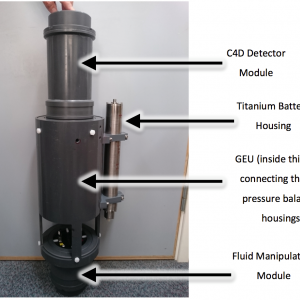Since the industrial revolution the CO2 concentrations in the atmosphere have increased from 280 ppm to over 400 ppm, and each year the oceans take up approximately 25% of the annually emitted anthropogenic CO2. In order to fully quantify the marine carbonate system there are four variables that can be measured; dissolved inorganic carbon (DIC), pH, total alkalinity and partial pressure of CO2. By measuring two of the four variables the others can be determined. Of these variables DIC is the only one without both an underway and in situ sensor, despite being one half of the preferred pairs for observing the carbonate system. To address this technological gap and increase the measurement coverage there is a clear need for an autonomous sensor capable of making quality measurements while having a robust, small physical size, and low power requirements. NOC has developed a full ocean depth rated autonomous DIC sensor, based on a microfluidic “Lab On Chip” (LOC) design. The DIC LOC sensor operates by acidifying < 1 ml of seawater, converting the DIC to CO2, which is diffused across a gas permeable membrane into an acceptor solution. The CO2 reacts with the acceptor resulting in a conductivity drop that is measured using a Capacitively Coupled Contactless Conductivity Detector (C4D). Each measurement takes ~15 minutes and the sensor can be set to perform calibrations in situ. Laboratory testing demonstrated this system has a precision of < 1 µmol kg-1. The sensor was deployed as part of a large EU project aiming to detect a simulated sub-seabed leak of CO2. Over multiple deployments in the North Sea the sensor collected data used to locate the leak. Several field tests have demonstrated the sensor has a precision of < 10 µmol kg-1.

